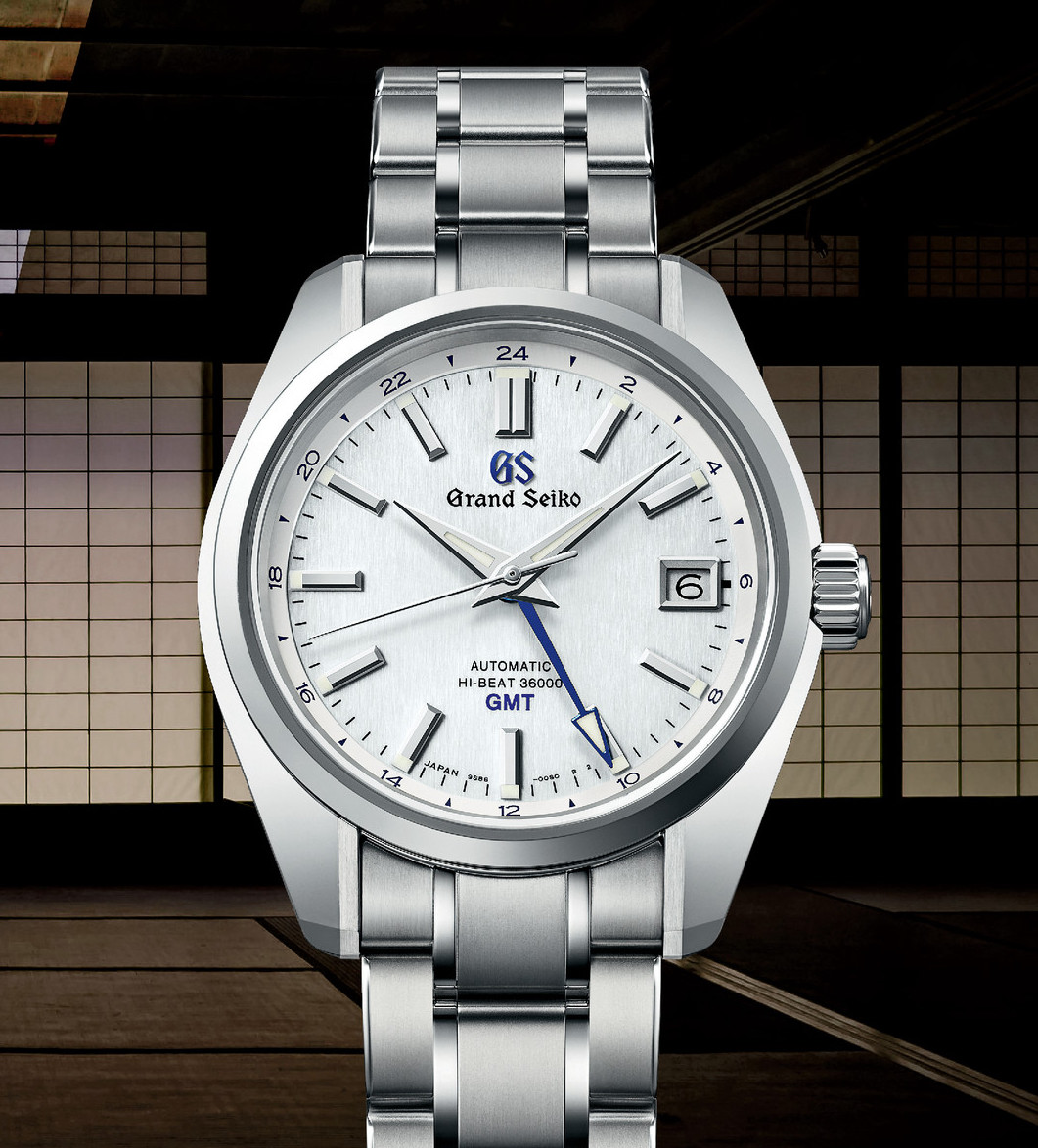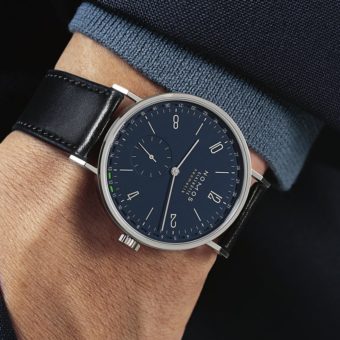This article was originally published in the September/October 2022 Issue of the WatchTime print magazine.
A white, finely structured dial, faceted hands, applied indexes and an almost entirely polished case: these features are familiar in elegant dress watches that look good but do little else than show the time. What happens if a watch manufacturer wants to combine these classic properties with functional features, and also wants to equip the new creation with additional functions and a robust exterior? Is it possible to build a watch that not only appeals to a client’s eye, but also to his insistence on a high degree of usability in daily life?
It is indeed possible, but only if you get everything right. And that’s exactly what Grand Seiko has done with its Hi-Beat 36000 GMT 44GS 55th Anniversary Limited Edition, our test watch, which was introduced in January 2022. The name refers to the 44GS, launched 55 years ago, whose handsomely shaped case serves as the model for this new Grand Seiko’s design. This new watch not only looks elegant, but also offers a high level of everyday usability: for example, in addition to a perfectly located date display, the Japanese manufacturer also has added a 24-hour hand with a corresponding scale around the edge of the dial.

The additional function is so cleverly integrated that it’s hard to imagine this timepiece without it — not to mention the function’s usefulness: if you cross a time zone boundary, you simply pull the crown out to its first position and rotate it to propel the main hour hand forward or backward in one-hour increments. At midnight, the date jumps forward or backward as necessary, as you would expect from a travel watch. The blue hand stoically remains in its original position to show the time in your home time zone throughout the journey. Those who prefer to stay at home will appreciate the quick adjustment for the hour hand, which makes it easy to switch between daylight saving time and standard time because the movement continues to run, thus preserving the correctness of the minute and second.
But that’s by no means the end of this watch’s functional features. Grand Seiko also includes its in-house luminous material called Lumibrite. This luminous substance is nearly unnoticeable during the day, but effectively illuminates three of the four hands and all 11 hour markers at night.
And then there’s the choice of material — titanium, which gives this new Grand Seiko an advantage over pure dress watches. The case and bracelet are made of this robust but lightweight metal, although all the polished parts look more like stainless steel. And this appearance is intentional. To achieve it, the manufactory created its own high-intensity titanium alloy. The alloy’s uncommon hardness exceeds that of conventional titanium and makes it possible to apply Grand Seiko’s characteristic “Zaratsu” polishing, which results in especially smooth and distortion-free reflective surfaces that shine as brightly as stainless steel.
Titanium also considerably reduces weight. Even before we shortened the bracelet, our test watch weighed only 105 grams. Thanks to this low overall weight, both the supple link bracelet and the case fit very comfortably on your wrist. And the case is by no means ultra-slim. It’s 14 mm in height and has the typically complex shape of a Grand Seiko.

The Japanese design tradition in general and Grand Seiko’s brand philosophy in particular both take elements of local culture and nature and incorporate them into the design of new products. Some Japanese watch dials evoke the colors of maple leaves in autumn, the texture of birch bark, the grain of snow, or the tracks in the gravel of Zen gardens. In addition, some of Grand Seiko’s movement bridges recall the contours of the famous Mount Fuji or Mount Iwate. The goal is never to produce a realistic representation, but always to create subtle impressions.
The dial of the new model that we tested recalls traditional Japanese sliding doors, which are covered with paper that diffuses incoming light and softens its harshness. The dial’s light, airy, paper-like structure can be recognized by an attentive observer who gets close to the watch’s face. But viewed from arm’s length or farther away, the dial appears white and smooth. This corresponds with the Japanese tradition of subtlety and understatement, while also expressing modest luxury, because the dial’s special surface is visible only at close range.
And speaking of luxury, this watch costs $8,500 and is therefore not one of those models that you might buy on a whim. The harmonious combination of elegant design and versatile functionality mentioned earlier is available for this price. But that’s not all. If you turn the watch over, you’ll see a manufacture movement with numerous technical advantages. The highly efficient, bidirectionally active Magic Lever double-pawl winding system harnesses the rotor’s kinetic energy to keep the tested Grand Seiko Caliber 9S86 running for 55 hours. The manufacturer guarantees precise timekeeping throughout this interval, with precision of between -3 and +5 seconds per day. Among other contributors to the accurate rate, the balance oscillates at a speedy pace of 36,000 rather than the usual 28,800 vibrations per hour. This means that the seconds hand advances through 10 steps per second rather than eight. To put it simply, a higher balance frequency generally means a greater likelihood of precision because the deviations are within a narrower range of the optimum.
On an electronic timing machine, a Witschi Chronoscope X1, our test watch measured a daily loss of 2.3 seconds, confirming that it stayed within the limits specified by Grand Seiko. During a wearing test of several weeks, it settled toward the lower limit of the permissible range with a daily loss of 3 seconds. Loss rather than gain is generally not welcome, but it can be tolerated when it’s as slight as it is here, especially because the values in the six positions cluster within a narrow range of just 4 seconds.

Grand Seiko not only manufactures common components such as bridges and plates in-house, but also fabricates critical parts such as mainsprings and even hairsprings, for which the manufactory has developed its own high-performance alloys. But individualized solutions are not only found in the depths of the movement, they can be seen on the surface. Peering through the transparent pane of sapphire crystal in the back of our test watch, we didn’t see a standard, semicircular, steel-colored rotor, but instead found a circular, skeletonized component with a gold-colored, irregularly structured surface and an integrated disk with an engraving of the Grand Seiko lion.
The manufactory relies on in-house electrolysis to give the rotor an unconventional color and texture. During the process, a layer of oxide forms on the surface of the titanium rotor. This coating acquires its desired gold tone when its thickness is precisely right. Some may wonder how a circular rotor can create enough inertia by responding to the natural motions of the wearer’s wrist. Quite simply, three rivets join the rotor to an arc-shaped weight that runs around half of the rotor and can only be seen if you look very closely.
If you want a comprehensive description of the Grand Seiko Hi-Beat 36000 GMT 44GS 55th Anniversary Limited Edition, you would need to expand its list of attributes. It is not only elegant and functional, it also offers a variety of individualized solutions ranging from the dial’s special paperlike appearance, to the case and bracelet made from the brand’s proprietary titanium alloy, to the quickly oscillating balance with in-house components. Unfortunately, only 1,200 buyers worldwide will be able to enjoy the versatile SBGJ255 on their wrists — a direct descendent of the 44GS from 1967 that established, once and for all, the Grand Seiko style.
To learn more about Grand Seiko, click here, and to subscribe to the WatchTime print magazine, click here.







Steve